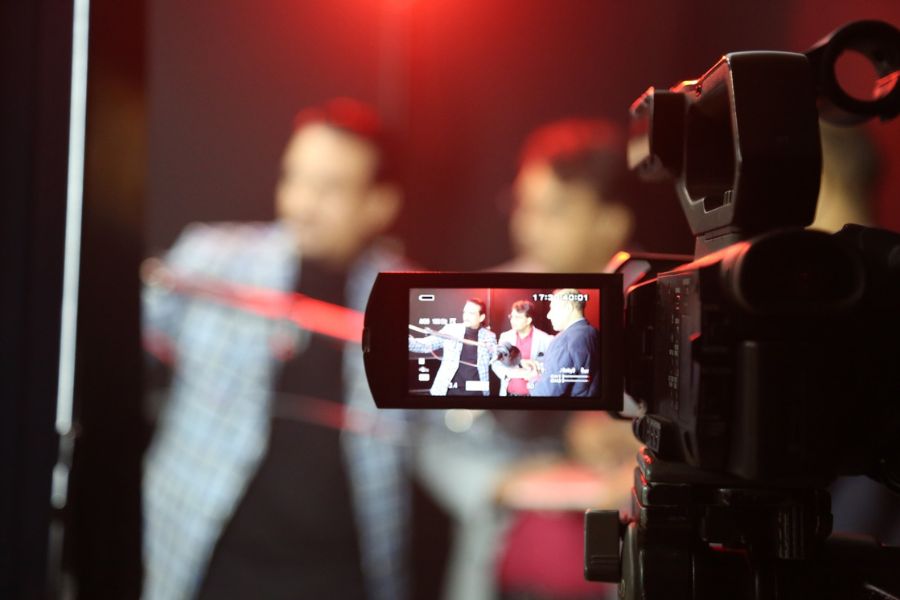Table of Contents
As a filmmaker, I’ve always believed that cinematography is the soul of storytelling on screen. It’s not just about capturing images; it’s about evoking emotions, creating atmosphere, and drawing the audience deeper into the narrative. In this blog, we’ll delve into 19 powerful cinematography techniques that can truly captivate your audience and elevate your filmmaking to new heights.
General Cinematography Techniques:

1. Camera Angles:
Camera angles play a pivotal role in shaping the audience’s perspective and understanding of a scene. Whether it’s the unsettling feeling of a dutch angle, the sense of vulnerability conveyed through a low angle, or the dominance portrayed in a high angle shot, each angle adds a layer of meaning to the story. For example, in Christopher Nolan’s “The Dark Knight”, the dutch angles during intense scenes heighten the tension and unease felt by the audience.
How it works: By tilting the camera, filmmakers can portray characters as powerful (high angle) or vulnerable (low angle).
2. Shot Composition:
Shot composition is the art of arranging elements within the frame to create visually appealing and meaningful images. The rule of thirds, leading lines, and framing techniques guide the viewer’s gaze and emphasize key elements of the scene. Take for instance the iconic opening shot of “The Shawshank Redemption”, where the leading lines of the prison yard draw the audience’s attention to the central character, Andy Dufresne, as he stands in solitude.
How it works: Arranging elements within the frame (like lines or objects) guides the viewer’s eye.
3. Camera Movement:
Camera movement adds dynamism and fluidity to a scene, enhancing its visual impact. Whether it’s the sweeping panoramic shots of a landscape, the subtle tilting to reveal a hidden detail, or the smooth tracking of a character’s movement, each movement choice contributes to the storytelling process. Think of the exhilarating car chase sequence in “Mad Max: Fury Road”, where the relentless tracking shots immerse the audience in the heart-pounding action.
How it works: Moving the camera can add dynamism, reveal details, or follow characters.
4. Focus:
Center control, including shallow profundity of field, profound profundity of field, and center pulling, coordinates the watcher’s consideration and makes a feeling of profundity inside the casing. In the hauntingly beautiful film “Blade Runner 2049”, director Denis Villeneuve employs shallow depth of field to isolate characters within the futuristic cityscape, emphasizing their emotional isolation amidst the vast urban landscape.
How it works: Lighting creates mood, tone, and atmosphere—think dramatic shadows in film noir or soft light in a romance.
5. Lighting:
Lighting sets the mood, tone, and atmosphere of a scene, shaping its visual aesthetic and emotional resonance. Whether it’s the dramatic interplay of light and shadow in film noir or the soft, diffused light of a romantic comedy, lighting can evoke a myriad of emotions. Consider the iconic “Godfather” trilogy, where the use of three-point lighting adds depth and dimension to the characters, highlighting their inner turmoil and moral complexities.
6. Color Grading:
Color grading is the process of altering and enhancing the color palette of a film to achieve a desired aesthetic or mood. From the vibrant hues of a Wes Anderson film to the desaturated tones of a post-apocalyptic landscape, color grading can profoundly impact the viewer’s perception of a scene. Take, for example, the visually stunning “The Grand Budapest Hotel”, where the rich, pastel colors evoke a sense of nostalgia and whimsy.
How it works: Adjusting color palettes can drastically change a scene’s feel—from vibrant to desaturated.
7. Camera Lenses:
Camera lenses, including wide angle, telephoto, and prime lenses, offer filmmakers a range of creative options for capturing different perspectives and visual styles. Each lens has its own unique characteristics, from the expansive vistas captured by a wide angle lens to the intimate close-ups achieved with a telephoto lens. Look at the masterful use of wide angle lenses in Stanley Kubrick’s “The Shining”, which accentuates the eerie vastness of the Overlook Hotel and intensifies the sense of isolation felt by the characters.
How it works: Different lenses offer unique perspectives—wide angles capture expansive views, while telephoto lenses zoom in for close-ups.
8. Camera Shots:
Camera shots, such as close-up, medium shot, and wide shot, dictate the scale and intimacy of a scene, as well as the viewer’s relationship to the characters and environment. A close-up shot can convey raw emotion and vulnerability, while a wide shot can establish context and spatial relationships. Think of the emotionally charged close-ups in “Schindler’s List”, which capture the anguish and desperation of the characters amidst the horrors of the Holocaust. Best Camera For Filmmaking: DSLR Vs. Mirrorless Vs. Cinema 2024
How it works: Close-ups, medium shots, and wide shots establish intimacy, context, and relationships within a scene.
9. Camera Movement:
Dolly zoom, steadicam, and drone shots offer filmmakers innovative ways to capture dynamic and immersive footage. Whether it’s the disorienting effect of a dolly zoom shot or the fluidity of a steadicam tracking shot, each movement technique adds a distinct visual flair to the storytelling process. Consider the iconic dolly zoom shot in Alfred Hitchcock’s “Vertigo”, which heightens the protagonist’s sense of vertigo and psychological turmoil.
Dolly zoom: A technique that zooms in while simultaneously pulling the camera backwards, creating a disorienting effect (e.g., “Vertigo” [1]).
Steadicam: A stabilizing mount that allows for smooth camera movement, even during running or walking shots.
Drone shots: Capture aerial footage, offering a bird’s-eye view of the scene.
Advanced cinematography techniques:
10. Slow Motion:
Slow motion can emphasize the beauty and intensity of a moment, allowing the audience to savor every detail and nuance. From the breathtaking slow-motion fight scenes in “The Matrix” to the poignant slow-motion sequences in “American Beauty”, this technique can evoke a sense of awe and wonder.
11. Timelapse:
Timelapse compresses time, revealing the passage of time in a visually stunning and captivating way. Whether it’s the bustling city streets transforming from day to night or the majestic clouds drifting across the sky, timelapse footage can add depth and dimension to a film’s narrative.
12. Hyperlapse:
Hyperlapse takes timelapse to the next level, combining movement with time-lapse photography to create dynamic and immersive sequences. From the frenetic pace of a hyperlapse journey through a bustling metropolis to the serene beauty of a hyperlapse tour through nature, this technique can transport the audience to new and unexpected places.
13. Steadicam:
Steadicam allows for smooth, fluid camera movement, enabling filmmakers to capture dynamic shots with precision and control. Whether it’s the iconic tracking shot through the halls of the Overlook Hotel in “The Shining” or the exhilarating chase sequence in “Children of Men”, steadicam shots can add a sense of immediacy and intensity to a scene.
14. Dolly Zoom:
Dolly zoom, also known as the Vertigo effect, creates a disorienting sensation by simultaneously zooming in and moving the camera backwards or zooming out and moving the camera forwards. This technique can convey a character’s sense of unease or psychological distress, as seen in the iconic dolly zoom shot in “Jaws”.
15. Handheld Camera:
Handheld camera adds a sense of immediacy and intimacy to a scene, immersing the audience in the chaos and emotion of the moment. From the frenetic handheld camerawork of Paul Greengrass in the “Bourne” series to the gritty realism of “The Blair Witch Project”, handheld camera can create a visceral and immersive viewing experience.
16. Rack Focus:
Rack focus shifts the focus from one subject to another within the same shot, drawing the audience’s attention to different elements of the scene. This technique can be used to reveal hidden details, convey emotional subtext, or create visual juxtapositions.
17. Negative Space:
Negative space refers to the empty or unoccupied areas of a composition, which can be used to create visual balance, tension, or emphasis. Whether it’s the vast expanses of empty space in “2001: A Space Odyssey” or the haunting emptiness of the desert landscape in “Lawrence of Arabia”, negative space can add depth and meaning to a scene, inviting the audience to contemplate the space between the elements.
18. Symmetrical Composition:

Symmetrical composition creates a sense of balance and harmony within the frame, drawing the viewer’s eye to the central axis of the image. Whether it’s the iconic symmetrical framing of Wes Anderson’s films or the meticulous symmetry of Stanley Kubrick’s compositions, symmetrical composition can evoke a sense of order and aesthetic beauty.
19. Asynchronous Editing:
Asynchronous editing involves the juxtaposition of images or scenes that occur simultaneously but are not directly related in terms of time or space. This technique can create tension, ambiguity, or thematic resonance within the narrative. Think of the groundbreaking use of asynchronous editing in “Pulp Fiction”, where multiple storylines intersect and overlap in unexpected ways, challenging the viewer’s perception of causality and chronology.
Conclusion
In conclusion, cinematography techniques are the cornerstone of visual storytelling, weaving together various methods such as camera angles, shot composition, movement, lighting, and more to evoke emotions and immerse audiences in the narrative. These techniques, ranging from fundamental principles to advanced approaches, elevate filmmaking to new heights, leaving a profound impact on viewers long after the credits roll.
FAQs about Cinematography Techniques
1. What are cinematography techniques?
Cinematography techniques are various methods used by filmmakers to capture and manipulate visuals in order to enhance storytelling. These techniques include camera angles, shot composition, camera movement, focus manipulation, lighting, color grading, camera lenses, and advanced techniques like slow motion and hyperlapse.
2. How do cinematography techniques contribute to storytelling?
Cinematography techniques play a crucial role in shaping the audience’s perception and understanding of a scene. They help evoke emotions, create atmosphere, establish mood, and draw the audience deeper into the narrative by using visual elements effectively.
3. What are some examples of basic cinematography techniques?
Basic cinematography techniques include camera angles, shot composition, camera movement, focus manipulation, lighting, and color grading. These techniques are fundamental in creating visually appealing and meaningful images that enhance the storytelling process.
4. Can you explain how camera angles affect storytelling?
Camera angles, such as high angles, low angles, and dutch angles, influence the audience’s perspective and understanding of a scene. They can convey characters’ emotions, relationships, and power dynamics, thus adding layers of meaning to the story.
5. How do advanced cinematography techniques differ from basic ones?
Advanced cinematography techniques, such as slow motion, hyperlapse, and asynchronous editing, go beyond the basic principles to offer innovative ways of capturing and presenting visuals. They add depth, creativity, and uniqueness to filmmaking, allowing filmmakers to create more immersive and impactful cinematic experiences.

